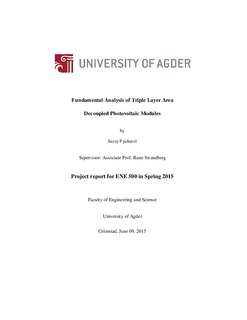| dc.description.abstract | The main objective of this work is to analyse the area decoupled triple layer photovoltaic module, by application of voltage matching under AM 1.5 light spectrum. This includes, calculation of detailed balance efficiency, calculation of optimal numbers of cells in each layer to achieve voltage matching comparisons with independently operated triple layer stack. Performance change under various different scenario is also observed. We have used MatLab programing software for all our analysis i.e., plots and calculations.
At first we investigated the optimal efficiency of independently operated cells of triple layer stack. Then applying area decoupling technique in a triple layer voltage matched module, we analysed the performance of such module under AM 1.5 spectrum. Upon comparisons the voltage matched module performed similarly to the independent stacks with only slight optimal efficiency difference, which occurred due to calculation round-off. If perfect area decoupling is achieved then it should be exact. Different sets of available semiconductor materials which are non-toxic are tried out in the analysis to find the best possible combination which gives optimal result. Lastly the performance of such optimized voltage matched area decoupled photovoltaic modules under other different spectra is studied. Which showed our area decoupled voltage matched module performed similarly to the independently operated stacks of cells under other different spectra too with no or only slight variation in efficiency.
The methods adapted to get the results are described in this report. The results show that the voltage matched tandem module, which is area decoupled gives detailed balance efficiency of 51.2 under numbers of cells in each stack at 32, 60 and 118, for top, middle and bottom layer respectively, with 60 silicon cells layer at middle layer. This tandem module performs similarly as the independently operated stacks under same condition. But change in spectrum affects its optimal performance due to spectral mismatch. If the area de-coupled module is optimized for the AM1.5 spectrum, it will be a little less efficient than an independently operated stack when the spectrum changes. | nb_NO |
